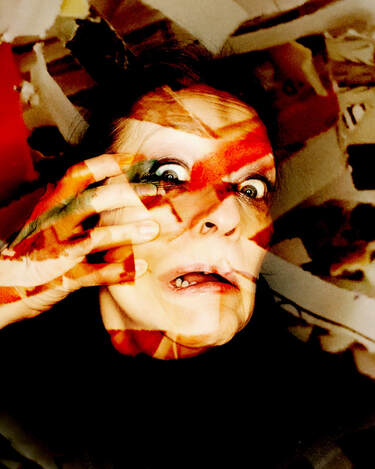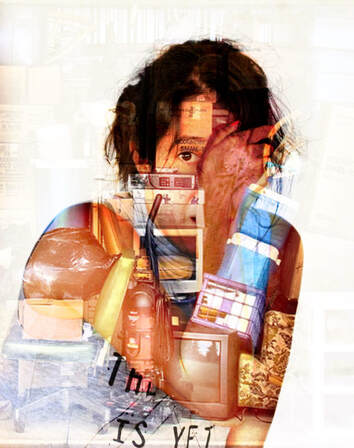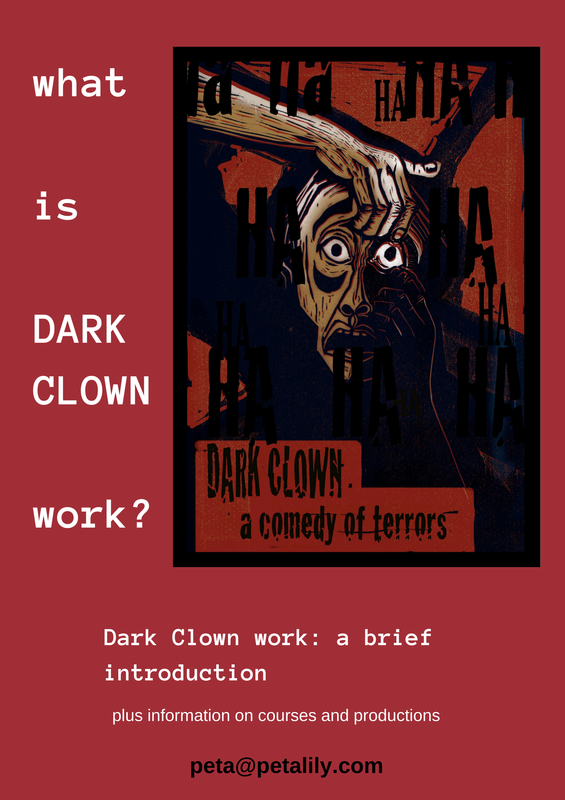
A list of Key Concepts (or frequently used phrases) for Dark Clown practice (as part of the 'Clown & Dark Clown Course' and the 'Level 2 Dark Clown Course').
It's a good-sized list and might feel like a lot but it all flows together in the room - the Clown & Dark Clown course progresses in a way that is fun and enlivening – there are practical exercises for each principle and we get there step by step.
These principles and techniques become understood and assimilated experientially. The Level 2 Dark Clown Course builds on ground gained and gives more opportunity to play with the Dark Clown Scenarios e.g. this one.
Clown/ Red Nose Clown
There are many different types of Clown, for the purposes of teaching on the Clown & Dark Clown course, I use ‘Red Nose Clown’ as a handy distinction from Dark Clown. (I use Red Nose to refer mostly to the Lecoq-lineage of clown regardless of whether a player uses a painted or rubber nose or different coloured nose or no nose at all in their clowning).
Troubled Laughter
In the introduction I give into the Dark Clown work proper (on a course), I usually tell the story of how, watching a scene in a show I saw in 1980, I first experienced what I later came to call Troubled Laughter. From my book-in-progress: “I laughed, while at the same time thinking 'I shouldn’t be laughing at this’. I laughed with a particular sensation in my ribs and lungs. I laughed with hot cheeks. That ‘shouldn’t’ wasn’t simply the transgression of naughtiness, it was something else. I felt awful and I was somehow glad to feel awful because what I was witnessing was a depiction of an appalling predicament. As much as it was ghastly, it was somehow a relief to sit there and make a noise, to find a noise being released out of me; to give expression to a conflicted response via this rhymical release of the breath, to physically and vocally resonate with the stage action.”
Marginalised Emotions
Imagine human expression were expressed as a line or continuum. Say that on one side we have the expression we might most often see in the Red Nose Clown, e.g. joy, silliness, loveliness, pride, bashfulness … near the centre of the line there may be grumpiness, crossness, even anger. But what about the other half of the line? Here we are heading for the expressions of the Dark Clown and what I call the Marginalised Emotions – such as: hyper-vigilance, fear, distress, shame, anguish, regret, guilt, humiliation, indignity, disbelief, grief, shock, absurdity, desolation, dread, despair, physical pain, horror, terror and existential dread. (Listed in no special or incremental order).
N.B.: No emotional recall is used in Dark Clown work. (Emotional recall is a technique used by some Stanislavsky teachers whereby the performer deliberately recalls an upsetting moments from their own life in order to summon emotion – we do not do this). The Dark Clown work relies on the natural human ability to pretend in a set of imaginary circumstances.
A believable verisimilitude of pain and distress
Verisimilitude means a likeness or a portrayal of – if the clown looks like they are enjoying their pain, the audience cannot experience the Troubled Laughter which is one of the defining characteristics of the Dark Clown. In order to Implicate the Audience (see below), the Dark Clown player needs to create / present ‘a believable verisimilitude of pain and distress’ by using rhythm, timbre, energy and imagination, using a set of given circumstances. (It is ‘believable’ because the Dark Clown player pretends well enough and the audience, when they enter a theatre space, are usually ready to become engaged in the world and are ready to ‘suspend disbelief’.)
Dark Clown as distinct from Philippe Gaulier’s Bouffon work
I try not to mention Bouffon in the workshop because if people don’t already know what it is, it takes extra time to explain it and it may confuse people – but if someone asks, I make the distinction this way.
Bouffon plays Satire – Dark Clown does not have the luxury to play satire.
(The historical roots of Bouffon - it is said – are based on a tradition that the outcast had one day of the year to enter the church or village and mock those who had privilege. The Dark Clown does not have the luxury to mock. The Dark Clown is concerned with how to survive the next 30 seconds.)
Comedy Craft
This is a collection of principles and techniques (rhythm, phrasing, musicality, timbre, clocks, beats, contrast, repetition, call backs, nudges, alternation, acceleration/deceleration, escalation (snowballing), micropauses, spatial embroidery etc) that can then be applied to generate laughter in Dark contexts.
Clocks/ Clocking
A part of comedy craft - Clocking is when an actor (or player) looks straight at the audience giving them a chance to understand (or simply notice) what the character is (or might be) thinking. A player can also ‘clock’ an object or another performer. Comes from English usage of a clock face.
Enforced Performance:
For some exercises we imagine a prison scenario – the purpose of this is to Raise the Stakes* to help the release into the Marginalised Emotions. I may also mention Life or Death Stakes.
Hyper-vigilance is a natural response to fear. It’s when you are highly alert to any movement or sound, perceiving it as a potential source of threat. In Dark Clown work, this replaces the 'complicité' style of eye-contact and responsiveness of the Red Nose Clown. In an enforced performance scenario, the player will give ‘a believable verisimilitude of hyper-vigilance’.
Extraordinary Physiological Response
With sufficient (imaginary, of course) pressure, logical thought stalls, emotion short-circuits and the player can find themselves releasing into a panicked amygdala response, allowing the audience the possibility to witness a spontaneously-released extraordinary physiological response (a pulsing brow vein, an involuntary twitch or flinch ... ). This is one of the compelling features of the Dark Clown work.
The EPR is in fact a motif. This is something you can see in Clown, comedy and Commedia work where the performer creates motifs (succinct, repeatable gestures, often combining sound and movement, and aimed to charm the audience or be a laughter nudge for the audience.) The EPR is a motif of a different flavour, but still designed to create laughter, or prime the laughing gear for future potential laughter.
As part of Comedy Craft, I emphasise that laughter is a physiological phenomenon – I speak of priming** (priming as you prime a motor – see below) the ‘laughing gear’. Laughing gear is a colloquial Australian phrase for the mouth, but I use it to mean the lungs, heart, diaphragm (eyes and mouth/jaw are also important).
Carlo Boso Commedia dell’Arte Teacher - TAG Teatro di Venezia: ‘It’s easy to make people laugh, all you need to do is to control people’s breathing and their heart rate.’ (nowadays I prefer to say ‘affect’ rather than ‘control’).
The Cost
In a Red Nose Clown exercise, we love to see the Clown thinking and reacting - for example, when another clown in the scene/exercise is being praised. We love the micro expressions, the tiny momentary reactions or 'Tells'*** of humanity which the ‘Sad Normals’ (see below) take considerable pains to mask or suppress. In Dark Clown I call this the Cost. The psychological Cost, the visible processing of thoughts and emotions of humanity in extremis.
Cost / Palpable cost
I may use the phrase ‘we want to see the cost’ (as in : what does it cost them emotionally?). With the Red Nose Clowns, we love to see their humanity, their emotions. We specially enjoy seeing this in the eyes: the micro-expressions of pride, affront, surprise, confusion, disappointment or other thought processes. Also in tiny head turns or spontaneous micro gestures, or the breath. (In Dark Clown work, the audience gets to see how the Dark Clown player responds to a command or predicament where they must make a terrible choice, how they look when they are wrestling with themselves in the moment before they must jettison they dignity, or betray a fellow ‘prisoner’, and how they look when they must live with what they just did for the rest of their lives.)
Dark Side Play
Once players (i.e. course participants) are clear on the aims of the work – and then on the predicament, context and stakes, the play can begin. At this point we are looking for physical and verbal motifs, as well as the player being strategic (with regard to the audience’s state or reactions) with rhythms and vocal timbre / breath, space (where possible). Dark Side Play works the Comedy Craft together with the Marginalised Emotions.
High Stakes Predicament – course participants are invited to imagine ghastly or highly constrained / oppressive circumstances in certain exercises and scenarios in order to help fuel release into Marginalised Emotions, using Dark Side Play (comedy craft) in a way that hopefully produces laughter-provoking text or sounds and motifs (including Extraordinary Physiological Responses). (See below for explanation of Stakes) – aka Desperate Predicament (see also Impossible Choices below)
Humanity in Extremis
Dark Clown is in extremis or trying to survive. It is a more existential look at the human condition (yes some other kinds of Clown can go there too, but usually via moments of pathos).
The Dark Clown work I teach resonates with life-long personal questions: Come torture or duress, what choices would I make? When given appalling choices, how does one feel as one continues to exist after whatever ghastly choice was made? When oppression is so great that courage is punished by death (or worse) - what are the options? When exactly does one succumb to force? What does the word 'force' really mean?
Implicating the Audience
I use the term Implicating the Audience to refer to the Dark Clown practice where the performer or ensemble manage to create the conditions whereby the audience feel that they are somehow 'on the hook'/at cause/somehow responsible/or that they just feel guilty watching/or that their comfort is in stark contrast to the player onstage portraying the suffering. Although all audiences know that they paid for their ticket and walked in to watch a composed performance, they can, via the ‘suspension of disbelief’****, feel conflicted or shamed in their witnessing and even to a degree, culpable. While no one may actually think: 'Oh my, I must rush on stage and help these people', they feel compelled and conflicted that 'It is not me over there suffering.'
Allied to this is the Dark Clown concept of Troubled Laughter (see above) whereby the audience laughs and at some level feels troubled or shamed or conflicted in their laughter.
Impossible choices
As with Enforced Performance, or inside an Enforced Performance scenario, the player/prisoner may have to make a choice. We will see the Cost and we will witness Marginalised Emotions, possibly some Extraordinary Physiological responses (see above).
Red Nose Clown – as mentioned above there are a number of Clown lineages and types of clown – as a convenience I use the term Red Nose Clown to make a distinction between Dark Clown and most other types of Clown.
Ridiculous (a judicious use if the ridiculous)
Adding a skilful touch of the ridiculous to a ghastly situation is a useful technique to surprise the audience into Troubled Laughter. For example, in the Buzzer exercise, players employ clocks and beats and express the appropriate Marginalised Emotions (strategically, using comedy craft and with audience awareness). It’s helpful/an extra level of skill to add something ridiculous - e.g.: a feigned electric shock, presented believably, yet which causes the Dark Clown player to spin in a circle like a wind-up toy. Another example: in the setup for The Somali Pirates scenario, I give the players a back story where there is a small past niggle between the two hostages. They are instructed not to play this niggle, but to allow it to bleed into their reactions to the other within the larger predicament. This layering can produce compelling results – a portrayal of a genuine predicament of suffering, inflected with little micro-beats of flawed humanity – which, once released, can in turn release a further micro-beat of Marginalised Emotion- i.e. ‘Oh no, I was just selfish, in such an awful situation! I feel shame at my own behaviour.
‘Sad Normals’ a playful teaching phrase to encourage the compassion of the Red Nose Clown performer for the audience – The ‘Sad Normal’ is us in our normal life (in the supermarket, travelling to work having all our petty emotions etc). I say: ‘It is the Clown’s job to have all the emotions and thoughts the Sad Normals prefer to suppress or hide.
NOTES
*Raise the Stakes - Definition of 'raise the stakes'
a. to increase the amount of money or valuables hazarded in a gambling game. b. to increase the costs, risks, or considerations involved in taking an action or reaching a conclusion e.g. ‘The Libyan allegations raised the stakes in the propaganda war between Libya and the United States.’ – Collins English Dictionary
**Priming
(I use it to mean getting the ‘laughing gear’: i.e. heart, lungs and diaphragm nice and flexible/available, but this is the everyday meaning of priming an engine.)
- Fill the oil pan with a quality Break-In Oil.
- Prime the system by turning the oil pump with a power drill and Priming Tool, or with an external Engine Pre-luber.
- Rotate the crankshaft by hand, while priming the system. This ensures that oil gets around all the bearings and into all the internal oil passages.
***Tell – An involuntary micro piece of body language. ‘A tell in the card game poker is a change in a player's behaviour or demeanour that is claimed by some to give clues to that player's assessment of their hand. A player gains an advantage if they observe and understand the meaning of another player's tell, particularly if the tell is unconscious and reliable. Sometimes a player may fake a tell, hoping to induce their opponents to make poor judgments in response to the false tell. More often, people try to avoid giving out a tell, by maintaining a ‘poker face’ regardless of how strong or weak their hand is.’ – Wikipedia
**** ‘Suspension of disbelief’ – ‘Suspension of disbelief, sometimes called willing suspension of disbelief, is the intentional avoidance of critical thinking or logic in examining something unreal or impossible in reality, such as a work of speculative fiction, in order to believe it for the sake of enjoyment. Aristotle first explored the idea of the concept in its relation to the principles of theatre; the audience ignores the unreality of fiction in order to experience catharsis.’ – Wikipedia
PL – I think we could say involuntary suspension of critical thinking – due to the audience’s change in physiological state when seated altogether and watching well-crafted theatre. The growing field of Neuroscience suggests mirror neurones and kinesthetic responses are at play with a theatre audience.
If this document raises questions about the way the work unfolds on the course – go here.
If you'd like to support the writing on the book, please go here.

 RSS Feed
RSS Feed
